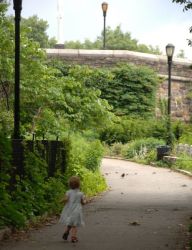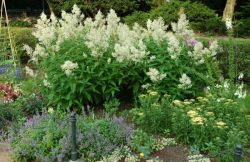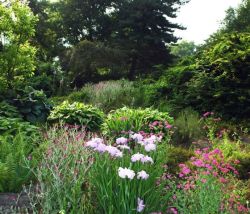Fort Tryon Park
NEW PUBLIC ART INSTALLATION ON THE CLOISTERS LAWN BRINGS SUITS OF ARMOR INTO THE OPEN AIR IN FORT TRYON PARK
NEW PUBLIC ART INSTALLATION ON THE CLOISTERS LAWN BRINGS SUITS OF ARMOR INTO THE OPEN AIR IN FORT TRYON PARKThursday, May 10, 2018
No. 35
http://www.nyc.gov/parks
“ARMORS” entails three pairs of sculptures, on view through September 2018
NYC Parks is pleased to present “ARMORS”, a new public art exhibition on view through September in Fort Tryon Park. This site-specific project in the park’s Cloisters Lawn, created by Icelandic sculptor Steinunn Thorarinsdottir, features three androgynous, humanlike figures in dialogue with suits of armor. The armor was cast from a custom 3D scan of a carefully chosen suit of armor from The Metropolitan Museum of Art’s permanent collection.
On Wednesday, May 9, NYC Parks Commissioner Mitchell J. Silver, FAICP, joined the Mayor’s Office for International Affairs Commissioner Penny Abeywardena, President of Iceland Guðni Th. Jóhannesson, State Assembly Member Carmen N. De La Rosa, Chairman of the Fort Tryon Park Trust Jeff Bauml, and Thorarinsdottir for an opening reception.
“The Cloisters are a magical part of Fort Tryon Park, and Steinunn Thorarinsdottir’s sculptures build on its existing medieval collection in such a beautiful way,” said Commissioner Silver. “The juxtaposition of these suits of protective armor out in the open in this picturesque park is quite extraordinary. We look forward to the many visitors who will encounter these pieces this spring and summer.”
“New York City and Iceland celebrate the values of international partnership and cooperation with the opening of this innovative exhibition in Fort Tryon Park,” said Commissioner Abeywardena. “We are delighted to make this artwork available to all New Yorkers in an exquisite outdoor setting, where residents and visitors alike can reflect on the artist’s fresh interpretation of history while enjoying everything our public park offers for the community.”
“Ancient armors are, in themselves, sculptural forms,” said artist Steinunn Thorarinsdottir. “They were developed for war, but they give a sharp insight into the psyche of man. The iconographical resonance that a suit of armor has taken on is a testament to how violence and the need to protect ourselves have been central to our lives for centuries; the armor is a materialization of man’s aggression. I wanted to merge medieval armors and ageless, androgynous figures in a way that would speak to the human condition today and in the past.”
For the selection of armor, Thorarinsdottir consulted Donald La Rocca, a veteran curator in The Metropolitan Museum of Art’s Department of Arms and Armor. La Rocca suggested three armors based on their quality and historical importance (each has spent decades on permanent display in the Museum), as well as relative variety and amenability to the 3D scanning process. With assistance from museum conservators, the armors were temporarily removed from display and meticulously scanned by the Met’s Imaging Department. The 3D image files were then sent to be cast in aluminum at a traditional lost-wax-method foundry outside of Shanghai.
“ARMORS” will be on view at the Cloisters Lawn in Fort Tryon Park through Thursday, September 13. Major support for “ARMORS” comes from the Icelandic Ministry of Culture and Iceland Naturally, with additional support from the Roger Smith Hotel, WOW air, and Scott White Contemporary. For more information on the artist, visit www.steinunnth.com.
Art in the Parks
In 2017 NYC Parks’ Art in the Parks program celebrated 50 years of bringing contemporary public artworks to the city’s parks, making New York City one of the world’s largest open-air galleries. The agency has consistently fostered the creation and installation of temporary public art in parks throughout the five boroughs. Since 1967, NYC Parks has collaborated with arts organizations and artists to produce over 2,000 public artworks by 1,300 notable and emerging artists in over 200 parks. For more information about the program visit www.nyc.gov/parks/art.
About “ARMORS”
The conceptual framework for “ARMORS” came about several years ago when Thorarinsdottir was living in New York and spending a lot of time in the Metropolitan Museum of Art’s arms and armor galleries—Gallery 371 in particular, from which all three of the installation’s armors were ultimately chosen. Through her interest in the department, she started to develop the idea to incorporate arms and armor into her own visual world of the human figure.
Central to the early stages of development of “ARMORS” was the idea that it needed to be displayed in an easily approachable, open-to-all public art setting. “Because armors today are mostly viewed in glass cases,” said Thorarinsdottir, “a distancing has developed from the original purpose of the armor. My idea is to erase that distance so that the viewer can feel first-hand the formidable and intimidating effect of the armor. The installation is intended to remind us of man’s uncanny strength in his helplessness against force, and I think anyone can relate to the concept of being the unarmed opponent in the face of a challenge.”
The project’s incorporation of armor—a form that is both distinctly iconographic and foreign to the artist’s own hand—marks an aesthetic and conceptual divergence for Thorarinsdottir, who is a celebrated pioneer in her home country of Iceland (the first female sculptor to have two solo shows at the Reykjavik Art Museum, 1982 and 1987). Her androgynous figure installations have been mounted in dozens of prominent sites around Reykjavik and beyond since 1976.
The androgynous figures central to Thorarinsdottir’s practice and “ARMORS” are cultural composites, made to represent the general human psyche rather than a distinct sex or ethnic identity. Though the installation’s incorporation of armor unavoidably references the current global prevalence of war, “ARMORS” isn’t principally about any one war or even the concept of war. Rather, it uses the suit of armor as an iconographic tool; a collective symbol of guardedness and power standing antithetically to—yet in curious dialogue with—the nude, open spirit of the humanlike figure.
The androgynous figures in “ARMORS” are characteristic of Thorarinsdottir’s sculpture practice since the debut of her first figural works in 1976. Previously, the figures have served alone as responsive interventions to their natural and architectural surroundings. For “ARMORS”, the artist first settled on the specific suits of armor before creating a figure in response to each.
Thorarinsdottir’s eldest son—who since 1997 has been the base model for the artist’s figure casts—posed for “ARMORS” in a way that subtly emulated the resting posture of each suit of armor. The physical result is that each figure appears capable of fitting directly inside its empty armor, while their mirrored postures also subconsciously establish a firmer bond between each contrasting pair. The interplay and dialogue between the opposing forms is deliberately open to social interpretation.
Check out your park's Vital Signs
Clean & Safe
Green & Resilient
Empowered & Engaged Users
Share your feedback or learn more about how this park is part of a
Vital Park System









